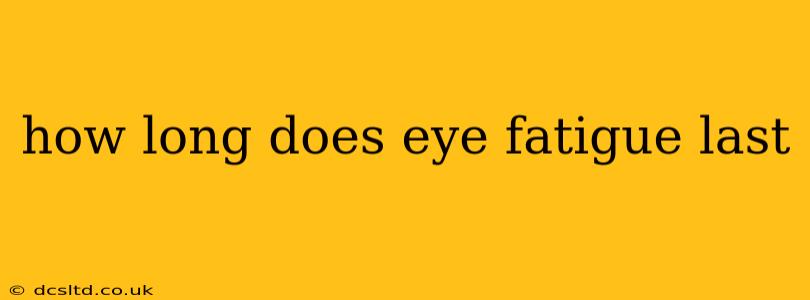Eye fatigue, also known as eye strain, is a common ailment characterized by discomfort and tiredness in the eyes. It's often a temporary condition, but its duration depends on several factors. This comprehensive guide explores the typical lifespan of eye fatigue, its causes, and how to alleviate symptoms.
What Causes Eye Fatigue?
Before we delve into the duration, understanding the root cause is crucial. Eye strain is frequently triggered by prolonged near-work activities like reading, using computers, or working with small objects. Other contributing factors include:
- Poor lighting: Insufficient or harsh lighting can strain your eyes.
- Incorrect posture: Slouching or improper screen distance can exacerbate eye fatigue.
- Dry eyes: Lack of sufficient lubrication can lead to discomfort and tiredness.
- Uncorrected refractive errors: Nearsightedness, farsightedness, or astigmatism can significantly increase eye strain.
- Medical conditions: Underlying medical conditions like migraines or thyroid issues can also contribute.
How Long Does Eye Fatigue Typically Last?
The duration of eye fatigue is highly variable. In most cases, mild eye strain resolves within a few hours after resting your eyes and adjusting your work environment. Simple measures like taking breaks, blinking frequently, and using artificial tears can significantly reduce discomfort.
However, persistent or severe eye fatigue might last for days or even weeks if the underlying cause isn't addressed. For instance, if your eye fatigue stems from uncorrected refractive errors, the condition will persist until you receive appropriate corrective lenses. Similarly, if it's linked to a medical condition, treatment of that condition will be necessary for relief.
How Can I Tell if My Eye Fatigue is Serious?
While mild eye fatigue is usually self-limiting, certain symptoms warrant a visit to an ophthalmologist:
- Persistent blurry vision: This isn't just temporary; it suggests an underlying issue.
- Double vision (diplopia): This indicates a more serious problem requiring medical attention.
- Severe eye pain: Intense or persistent eye pain shouldn't be ignored.
- Redness or swelling: If your eyes are consistently red and swollen, consult a doctor.
- Headaches associated with eye strain: Frequent headaches related to eye fatigue can be a sign of a more serious condition.
How to Relieve Eye Fatigue Quickly
Many simple strategies can quickly alleviate eye fatigue:
- 20-20-20 rule: Every 20 minutes, look at an object 20 feet away for 20 seconds.
- Blink frequently: Consciously blinking helps to lubricate your eyes.
- Adjust lighting: Ensure adequate, even lighting to reduce strain.
- Maintain proper posture: Sit upright and position your screen at the correct distance.
- Use artificial tears: Lubricating eye drops can provide relief from dryness.
- Take breaks: Regular breaks are essential to prevent prolonged eye strain.
Does Eye Fatigue Go Away on Its Own?
Often, yes. Mild eye fatigue typically resolves spontaneously with rest and lifestyle adjustments. However, if the underlying cause is not addressed (e.g., uncorrected refractive error), the eye fatigue will likely persist. Chronic eye fatigue requires a professional evaluation to determine the cause and appropriate treatment.
What are the long-term effects of untreated eye fatigue?
Prolonged or untreated eye fatigue can lead to various complications, including:
- Dry eye disease: Chronic dryness can damage the surface of the eye.
- Headaches and migraines: Eye strain is a common trigger for headaches.
- Blurred vision: Persistent strain can impact visual acuity.
- Reduced productivity: Eye fatigue can decrease concentration and work efficiency.
Therefore, addressing eye fatigue promptly is crucial to prevent these long-term consequences. If your eye strain persists or worsens, consulting an ophthalmologist is highly recommended.
Can eye drops help with eye fatigue?
Yes, lubricating eye drops (artificial tears) can often provide significant relief from eye fatigue, especially if dryness is a contributing factor. However, it's important to use eye drops appropriate for your condition and to avoid overuse. If your eye fatigue is severe or persistent, consulting an eye care professional is essential.
This information is for general knowledge and does not constitute medical advice. Always consult with a healthcare professional for any concerns regarding your eye health.
